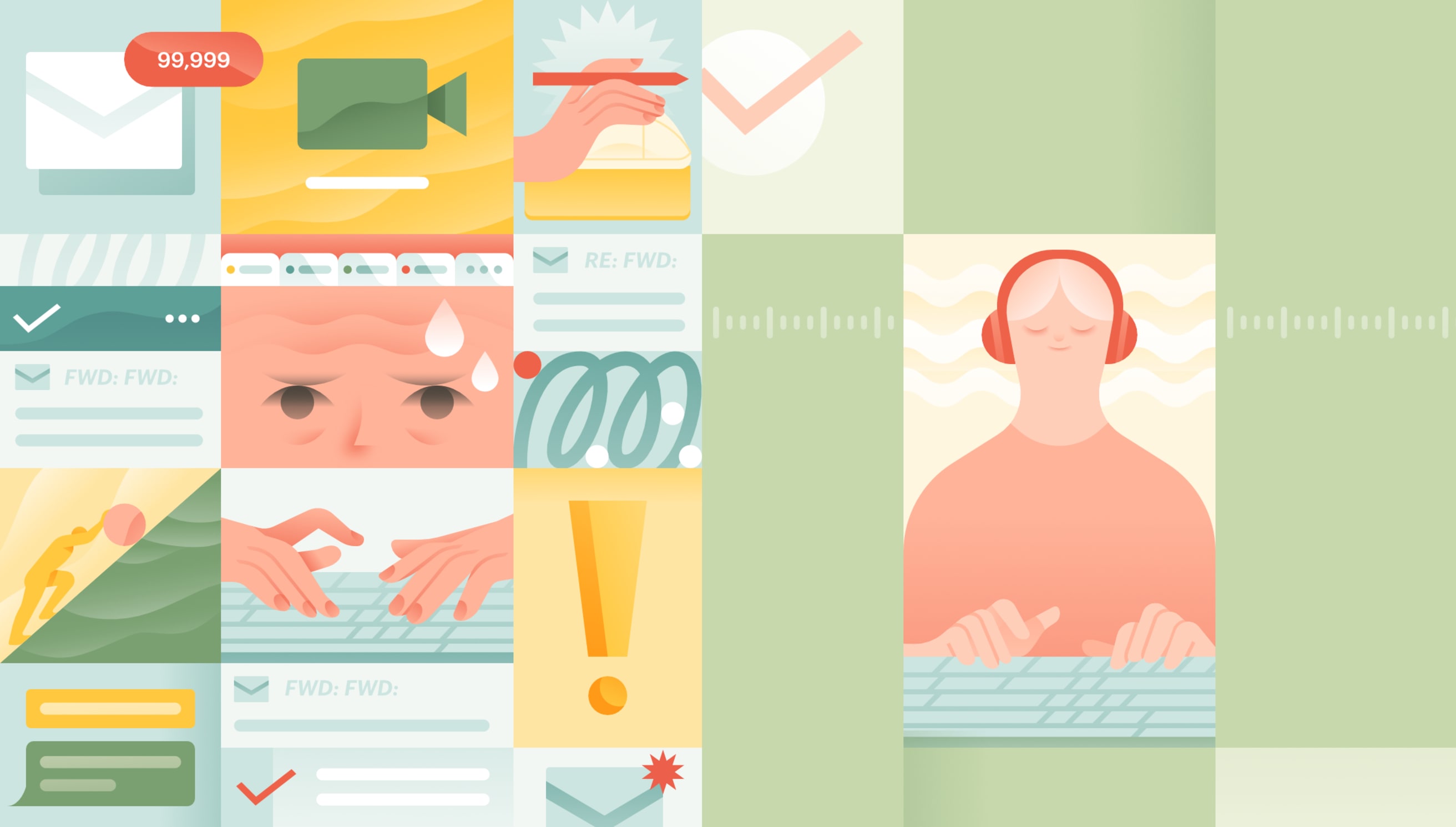Ever feel like you’re working nonstop every day? Finishing one task after the other, jumping from meeting to meeting, coworkers swinging by with “just a quick question,” and…before you know it, the day it’s gone.
You look down at your to-do list and realize you haven’t made any progress in the important things.
“Where is all my time going?”
“I need to work more efficiently!”
“Do I need to be faster?”
“Should I work a bit more…?”
👉 Here’s the thing: You don’t need to be faster, smarter, or achieve something every waking moment of your life to reach your goals.
The difference between being busy (constantly juggling tasks and responding to every little interruption) and being productive (making progress in important things) is just a mindset shift away.
In this article, you’ll learn strategies to shift your focus so you can conquer your to-do list and feel accomplished at the end of each day. Rather than asking yourself, “How can I do more in less time?” you’ll confidently reassure yourself, “I’m focusing exactly on what I should be doing right now.”
What it means to be busy vs. productive
Being productive means focusing on meaningful tasks that have an impact on long-term goals, while being busy means working on tasks without a clear sense of priority.
When you’re productive, you’re strategic and intentional about what tasks you want to complete in a day. But when you’re busy, you react to external demands and fill your day with meetings and activities that don’t contribute to your goals.
As Steve Covey, author of The 7 Habits of Highly Effective People, put it:
"The key is not to prioritize what’s on your schedule, but to schedule your priorities."
You may think your to-do list already covers your daily priorities. That everything you need to do is equally important and sometimes (just “sometimes”) something more important comes up during the day. Unfortunately, this mindset is at the heart of the busy vs productive dilemma.
So, are you productive or busy?
Being busy 😰 | Being productive 📈 |
Attending meetings that could’ve been an email | Only attending meetings with clear agendas where important decisions are made |
Having a never-ending to-do list | Having a short to-do list with key tasks |
Responding to immediate demands or interruptions | Scheduling specific times for deep work — without interruptions |
Multitasking and switching between tasks | Focusing on one task at a time |
Skipping breaks to “be more productive” | Taking regular breaks to avoid burnout and improve focus |
The first step to becoming more productive is to be honest with yourself and acknowledge that you might not be doing a great job at it. This can be challenging because being busy often gives you a false sense of productivity.
So, to clear up any doubts, here are some telltale signs that you’re caught in busy work.
Signs you're busy, not productive 🚩
Sounds simple, but hearing the words “I’m busy” coming out of your mouth more often than not is an early sign that you may need to reconsider your priorities.
Here’s a list of signs you’re stuck on busywork:
Lack of clear goals. With no clear direction, you may start to prioritize other tasks by urgency rather than their importance in the grand scheme of things. This means you’ll waste time on less critical tasks and make no significant progress in your goals.
Feeling overwhelmed. If you feel overwhelmed every time you glance at your to-do list, you may have too much on your plate. Trying to handle everything at once can scatter your efforts and reduce your progress.
Minimal progress. When you feel like you’re doing a lot every day, but you’re nowhere near completing your goals, you may be completing tasks that don’t contribute to your goals. This leaves you feeling unaccomplished and even more overwhelmed.
Overcommitments. Always saying “yes” to external demands can affect your ability to complete critical tasks. Your schedule fills up with responsibilities that weren’t yours to begin with, leaving little room for your own priorities.
Procrastination on important tasks. I get it; you want to avoid that big, challenging task on your to-do list. The sole thought of starting it fills you with anxiety and stress, so you opt for an easier activity first. You may feel busy, but at the end of the day, you’re not making progress in what truly matters.
Recognize some of your own behaviors? Let me assure you, you’re not alone. The next step to being productive is to start applying the following principles to change your focus.
How to start being productive
While there’s no switch you can flip to start being productive, staying busy and trying to maximize every moment of your day are some productivity myths you need to avoid.
Here’s how to (ironically) do less but achieve more by shifting your focus.
Focus on outcomes rather than outputs
It’s easy being busy. Overscheduling your day and crossing one task off your to-do list after another gives you a sense of accomplishment. At the end of the day, you look at the list of crossed-off tasks and feel like you did a lot.
And that may be true…but did you achieve a lot?
On the other hand, being productive can be hard because it means you have to stop and ask yourself difficult questions more regularly.
Is this task helping you get closer to your goals?
Will this task make an impact on your future success or that of your team?
Will completing this task move you forward?
If the answer to any of those questions is a “no,” you may be running in circles instead of a straight line. You’re focusing on outputs — the number of tasks you complete, rather than on outcomes — meaningful progress toward your goals.
For example, are you sure you want to keep working on reformatting that internal report template instead of working on preparing that proposal for a client? Or is color-coding your email labels more important than writing that blog post?
Probably not!
Whenever you start a new task, ask yourself, “Will this task contribute to my long-term goals?” If the answer is no, consider if it’s worth prioritizing right now.
Use the MIT (Most Important Task) method
The MIT method is a simple but effective approach in which you identify one or three high-priority tasks (HIT) that you need to get done by the end of the day.
Now, you may be thinking, “Just three? That’s easy! I can prioritize more than that.”
But just three tasks ensure you don’t over-commit your day. Even if your day fills out with external requests, you have the satisfaction of knowing you finished three tasks that contributed to your goals.
Here are quick tips for MIT:
Work on your HITs before everything else. This ensures critical tasks are completed as soon as you start your work day. If you wait until later to complete them, external demands may get in the way.
Combine with time-blocking or the Pomodoro technique. Schedule blocks of time to work on your HITs uninterrupted with time-blocking. However, if you think a task is going to take you a long time — and you’re not very eager to start — use the Pomodoro technique to break down that task into manageable chunks.
Avoid distractions. Distractions add to your cognitive load. Each interruption (even if it’s a small one) fragments your line of thought, and your mind becomes cluttered.
Organize your HITs by context. For example, if you have a day filled with meetings, work on HITs you can complete in a short time. If, on the other hand, your day is relatively free, work on longer HITs.
You can explore other personal productivity methods and choose which one works for you. Still, make sure to prioritize high-priority tasks or at least find your most important task and complete it.
Manage your energy levels
Your energy levels throughout the day depend on your circadian rhythm, which is also influenced by your chronotype. Are you an early bird or a night owl?
To keep things simple, let’s say you’re a morning person (sorry, night owls!)
According to RISE, a sleeping app backed by 100 years of sleep science, your productivity levels may look like this:
You wake up and experience grogginess.
Your first peak of energy is from 9 am to noon
The afternoon slump hits you after lunch between 1 and 3 pm.
Your second energy peak is between 4 and 6 pm.
Your brain starts to unwind and relax
Bedtime!
Here’s the trick to regulating your energy levels:
For tasks that require analytical work and focus, like coding, research, or planning, use your first peak of energy. This is when your cognitive functions are at their highest.
For tasks that require creativity, like writing, design, or brainstorming, the second peak of energy is better. This is when your mind is more relaxed, and you’re open to new ideas.
For administrative tasks, like responding to emails or routine tasks, the afternoon slump is a good choice. This is when your energy levels are low, so it’s the best time to tackle less demanding tasks.
If we take into account a 9 to 5 work day, scheduling your most important tasks in the morning — for your first peak — is your best bet. When you reach your second peak of energy, your workday is likely over but you can concentrate on hobbies like reading or writing.
Prioritize deep work over task-switching
If you’ve ever thought of using multitasking to get more done and be “productive,” think again. When you switch between two or more tasks repeatedly, it takes an average of 23 minutes to refocus on a task.
For example, say you’re writing a report for the marketing team. Then you get an email notification, so naturally, you check it. It’s a request for last quarter’s report. “This can’t take more than five minutes. I can do it right now,” you think. So you send your reply and get back to writing the new report.
But where were you? And what was the line of thought here? Right now, it looks like gibberish. You change between tabs and emails. Thinking…thinking. And you got it! But an average of 23 minutes has passed. And now another email notification catches your attention.
As you probably realized, this constant context-switching is a huge waste of time. It does keep you busy, but you’re not being productive. Cal Newport, author of Deep Work: Rules for Focused Success in a Distracted World, points out:
“If you service low-impact activities, therefore, you're taking away time you could be spending on higher-impact activities. It's a zero-sum game.”
Instead, practice deep work and focus on a single cognitively demanding task without distractions. Newport argues that deep work is essential for greater satisfaction (because you tackle high-impact tasks with it).
Say “no” to low-impact tasks
“The most powerful productivity tool ever invented is simply the word no.”
Have you ever heard the popular parable about a professor who uses a jar, rocks, pebbles, and sand to show his students how to prioritize important things in life? Because it could also apply here!
The rocks are your HITs
The pebbles and sand are low-impact tasks
The jar is the time you have available
If you fill your jar with sand and pebbles there’s no room for your rocks. But if you fill your jar with rocks first, there’s always space for some pebbles and sand.
Learning how to say no to low-impact tasks to prioritize your HITs can be incredibly challenging. Especially when you have a track record of saying yes. You may feel guilty or even responsible. But I want you to challenge yourself to visualize your jar and actively choose what you want to put in it.
If a coworker asks for your help on a task—and it HAS to be you—don’t feel pressured to say yes. Communicate with them and come to an agreement (maybe rescheduling the task) so both parties have what they need.
Delegate tasks to reduce busyness
Delegating is a quick cheat code you can use to free up your time and focus on more critical activities.
However, how to delegate a task requires careful thought. You can’t just randomly throw a task at your team, because you think it’s easy enough, and expect them to magically get it done. Here are some quick considerations you need in place:
Determine the complexity of the task: Can someone other than you do it?
Match the right person: Whose skillset or career path matches the task?
Provide clear instructions and a timeline: What exactly needs to be done? How should it be done, and by when?
Offer resources: What information, tools (permissions), or support will they need for the task?
Check-in regularly (if it’s a big task): How frequently should you check the progress of the task and give feedback?
💡Quick tip: If you consistently face a task that has the same inputs and outputs, you could create a standard process or use automation tools. After this, the task may require minimum intervention and you can more easily delegate to other team members.
Take breaks and prioritize life-work balance
Remember this article is about changing your focus and mindset about busyness vs productivity. A bunch of tips aren’t going to work if you can’t take a moment to unwind.
Up until now, you may think that if you’re productive any other time is spent being busy. The thing is, you could also be free. Disconnecting from work and having time for yourself is essential to avoid burnout and frustration.
According to a study, micro-breaks (less than 10 minutes) are effective in boosting well-being and performance, with longer breaks leading to even better outcomes. So, take breaks between demanding tasks and give yourself the necessary downtime to recharge.
Imagine if you finished all your tasks for the day just to do more. That’s just a never-ending to-do list. And this constant pressure can lead to productivity shame because no matter how much you do in a day, it’s never going to be enough. This is why it’s helpful to have a work shutdown ritual at the end of the workday.
And if you’re an unapologetic workaholic, schedule a pottery class, buy movie tickets, or invite friends over. This will force you to attend leisure activities.
How to Be Productive, Not Busy With Todoist
If you’re one of those people who need a bit of help to stay focused because external interruptions distract you from what really matters, having a to-do list with your priorities in plain sight may be your best option to be productive.
Here’s how you can use Todoist to overcome the busy vs productive dilemma.
Identify your high-impact tasks
Add all of the tasks you can think of to your Inbox. Don’t think about which ones are more important or urgent yet. The idea of this step is to have all of your tasks in your inbox to organize them.
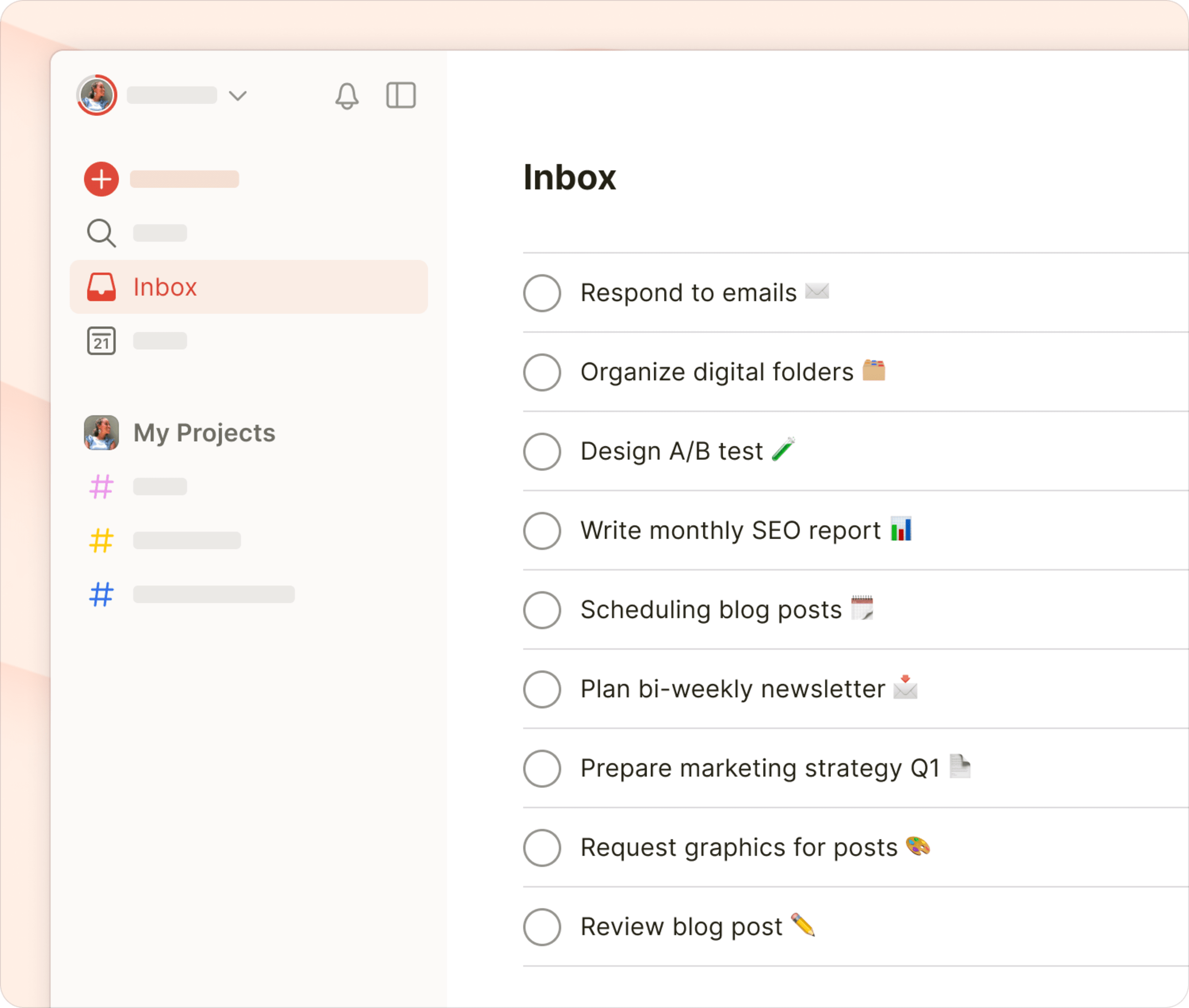
Create a label called “@HIT” or “high-impact”(for your high-impact tasks). Then assign that label to the tasks that impact your goals. If you have tasks for different areas, create projects to organize your tasks per category and move them there.
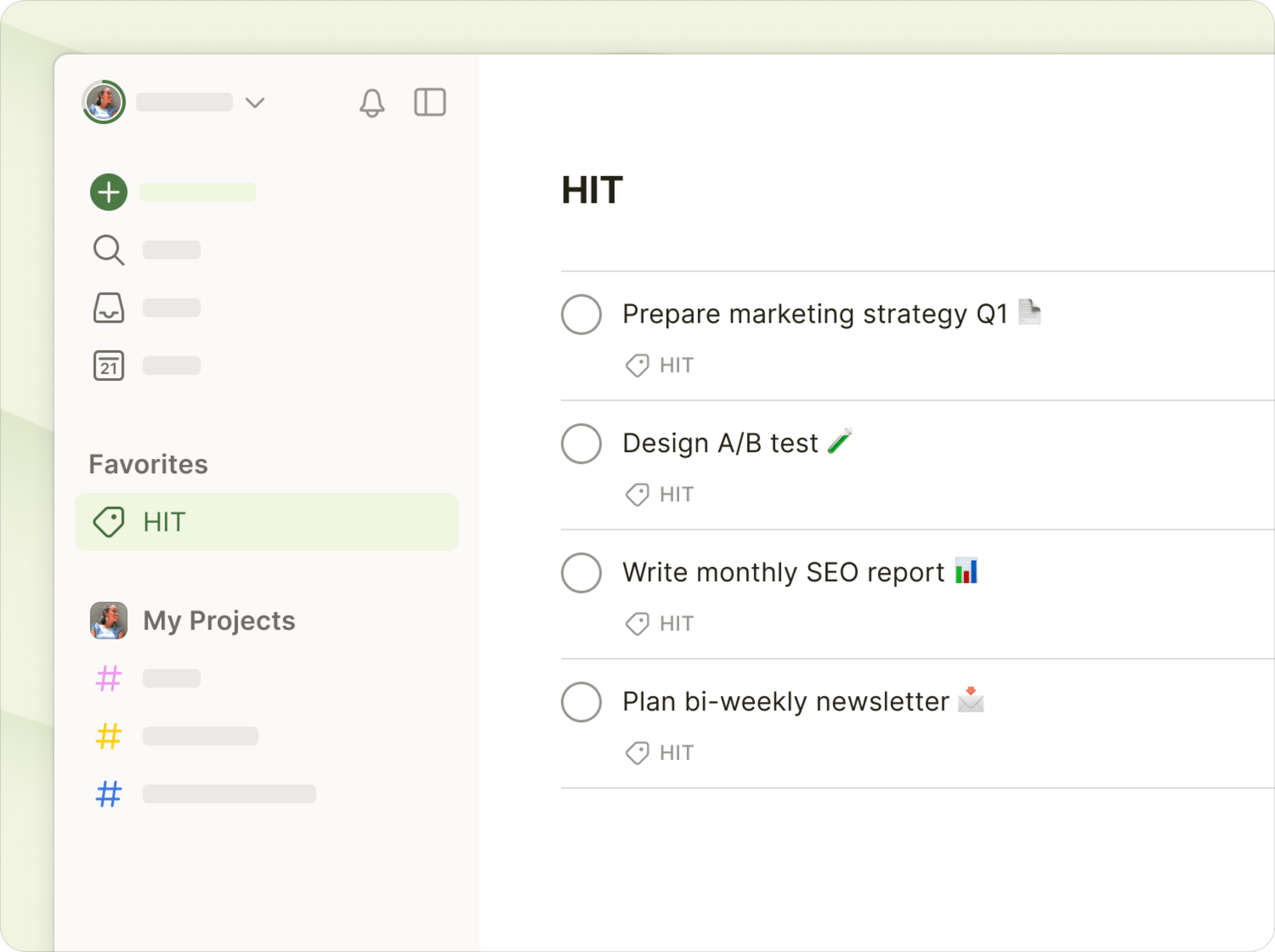
You can also use the priority filter to determine urgency or priority interchangeably.
Todoist tip: You can put your high-impact label or priority filter as a favorite to easily access the tasks that matter to you in the left-hand menu.
Choose your top three tasks
From your high-impact label choose the three tasks you want to complete today. You can use the priority filter to make sure they appear at the top of your list with their priority in red, orange, or blue.
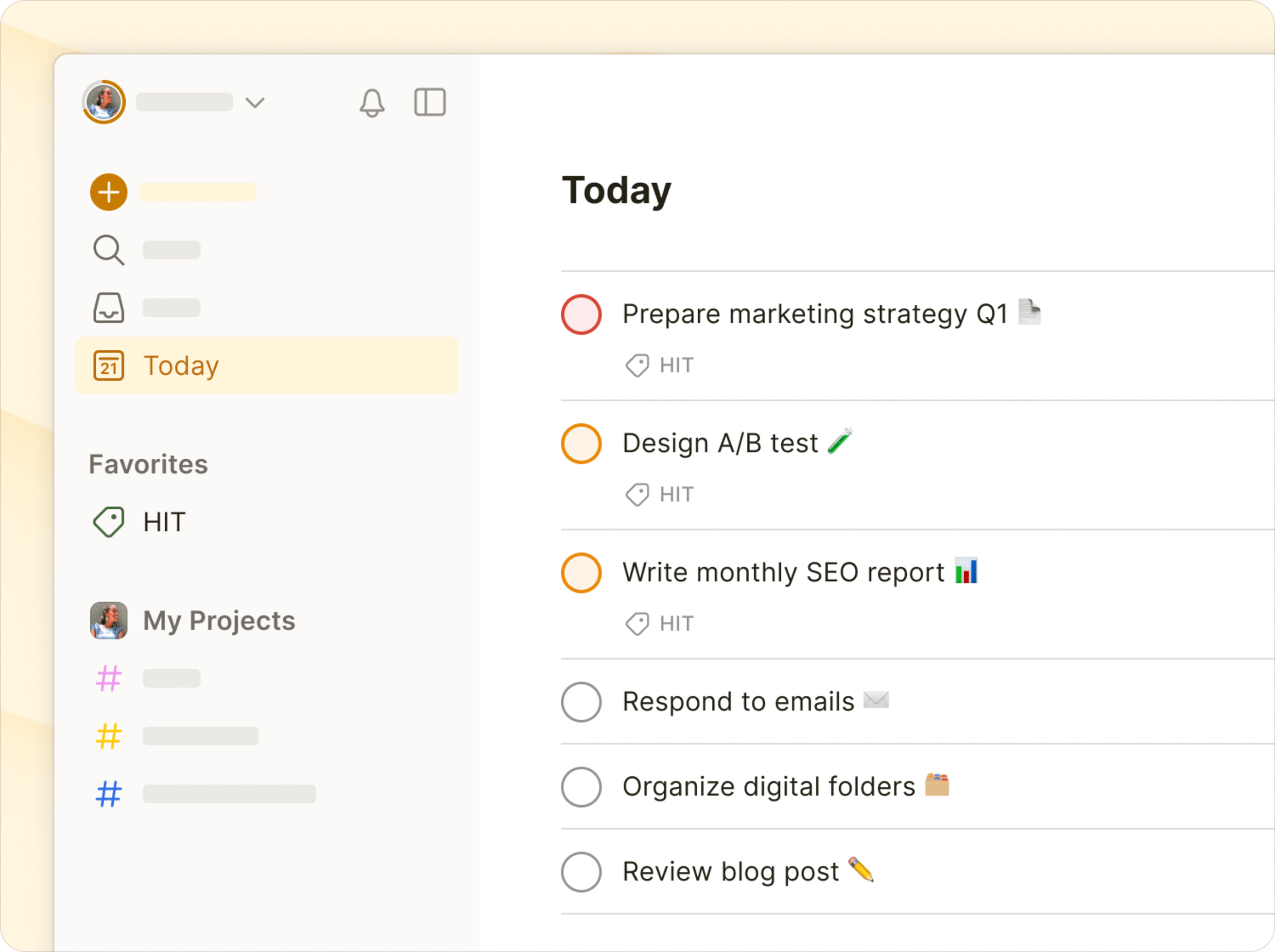
If there are other low-impact tasks waiting for you to complete, you can add them. Just don’t action them until your top three tasks are completed.
Delegate when possible
Check the tasks that appear in your Today and decide if you can delegate. Assign tasks to another team member and use the comments to leave instructions. You can also set a due date for the task.
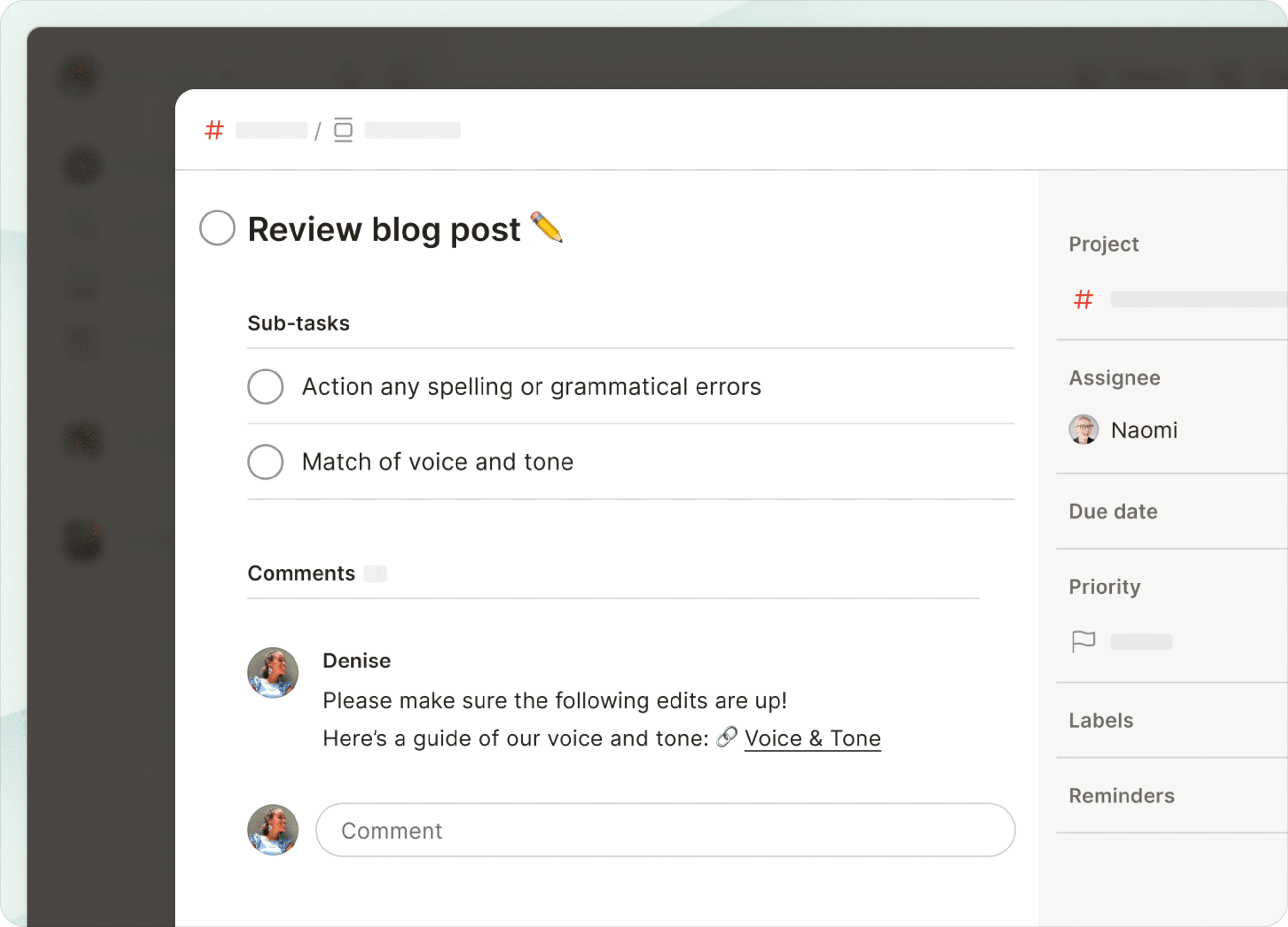
Todoist Tip: You can add the filter “Assigned by me” to your favorites to keep track of the tasks you’ve assigned to team members and their progress.
Plan, review, and adjust
When you get to work (or bonus points if you do this the day before), start by planning what HITs you are going to tackle in your Today view. You can also visualize which tasks you’ll prioritize during the week with your Upcoming view.
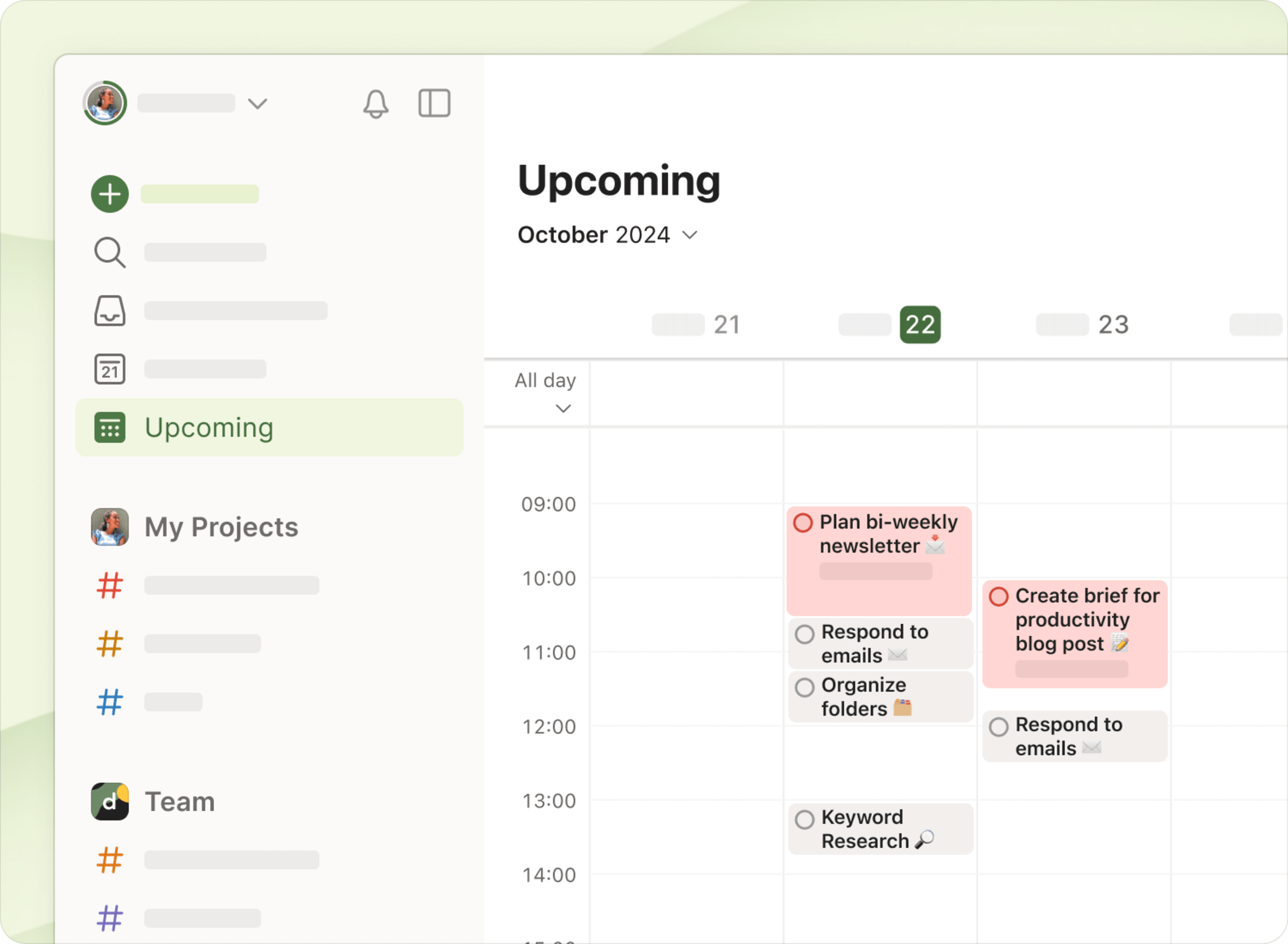
However, avoid scheduling too many tasks in advance so you can stay flexible and avoid stress for not meeting your goals.
Busy vs Productive is Just a Mindset Shift
“Be productive, not busy” is easier said than done. As you shift your focus on the busy vs productive dilemma, remember that sometimes the most productive thing you can do is: absolutely nothing.
So schedule some guilt-free time. Your brain needs it, your body craves it, and in the future, you'll thank yourself for starting the day with a fresh mindset and all the energy to be productive — at least in the first peak of your day.
According to the Pareto Principle, 20% of our tasks lead to 80% of our results. By identifying and completing two or three important daily tasks, you’ll be far less busy and more productive than ever. Remember that success lies, not in doing everything on your to-do list, but in doing the right things.
